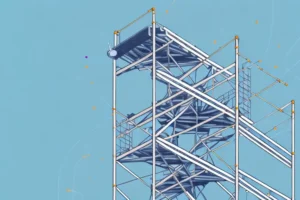For many workers and DIY enthusiasts, working at height is a common task that requires reliable equipment. In recent years, there has been a rise in the use of DIY towers – makeshift or non-certified scaffolding systems that individuals assemble themselves to work at elevated levels. However, industry experts like PASMA (Prefabricated Access Suppliers’ and Manufacturers’ Association), a leading authority in mobile access tower safety, strongly advise against the use of DIY towers due to the significant risks involved. This article will explore the dangers of DIY towers according to PASMA and why certified systems are crucial for working safely at height.
What Is a DIY Tower?
A DIY tower refers to a makeshift or non-certified scaffolding system that is assembled by non-professionals, often using unregulated or non-specialist equipment. These towers are commonly used by homeowners or workers attempting to save money or time by building their own structures for small construction, maintenance, or renovation projects. However, these structures are usually not built to meet professional safety standards.
1. Non-compliance with Safety Standards
One of the key reasons PASMA advises against DIY towers is that they often do not comply with proper safety regulations. PASMA emphasizes that all mobile access towers should conform to industry safety standards, such as BS EN 1004, which specifies the requirements for safe and compliant tower design. DIY towers rarely meet these standards and often lack important safety features like guardrails, stabilizers, and platforms with appropriate weight limits.
- Certified towers are tested rigorously to ensure they meet the necessary safety requirements, while DIY setups may cut corners to reduce costs.
- Without adhering to these standards, DIY towers expose users to a high risk of accidents, such as falls or collapses, which could result in severe injuries or even fatalities.
2. Risk of Structural Instability
The structural integrity of a DIY tower is often questionable. A certified tower is designed with durability in mind, ensuring it can withstand the loads placed on it and remain stable on uneven surfaces. In contrast, DIY towers are typically constructed from mismatched materials that may not be designed to bear the same loads or cope with external forces like wind.
- PASMA highlights that makeshift towers are often improperly secured, leading to tipping or collapsing, especially when workers move or apply additional pressure to the structure.
- Without a solid base, bracing, or outriggers, DIY towers are particularly prone to instability, which can endanger anyone using them.
3. Lack of Proper Assembly Knowledge
Another major concern PASMA identifies is the lack of knowledge about assembling and erecting DIY towers. Certified scaffolding systems come with detailed instructions and are typically assembled by trained individuals. In contrast, these towers are often put together by untrained workers or homeowners who lack the technical expertise required to ensure the tower is correctly assembled.
- PASMA-trained operatives understand how to safely erect a scaffold tower, secure it in place, and dismantle it without incident. DIY tower users often overlook critical safety steps such as securing the base, ensuring level ground, or locking all components correctly.
Improper assembly increases the likelihood of accidents, especially when users climb or perform tasks at height on a tower that hasn’t been properly secured or stabilized.
4. No Access to Guardrails and Other Safety Features
One of the primary safety features of a certified scaffold tower is the presence of guardrails, which help prevent falls – the leading cause of injury when working at height. PASMA stresses the importance of using towers that include properly fitted guardrails at every platform level. These products often omit these critical safety components, leaving workers vulnerable to falls.
- Guardrails provide essential protection, ensuring that workers are less likely to fall off the edge if they lose their balance.
- PASMA recommends avoiding any tower system that is not equipped with certified guardrails.
5. Inability to Support Load Requirements
PASMA advises against using DIY towers because they are not designed to support the same loads as certified towers. A certified scaffold tower is built to safely bear the weight of workers, tools, and materials, which are carefully calculated to ensure the tower remains stable. On the other hand, DIY towers often lack weight limit specifications and may collapse under the pressure of even moderate loads.
- Overloading a makeshift tower can lead to structural failure, especially if weak or unsuitable materials are used for the construction.
- Certified towers provide clear load capacity information, which helps to prevent overloading and ensures safe working conditions.
6. Higher Risk of Legal and Liability Issues
PASMA also points out the legal ramifications of using a DIY tower. In professional settings, failing to use compliant and certified equipment could lead to liability issues if an accident occurs. Employers are required by law to provide safe working conditions, and non-compliance with safety standards could result in legal action or fines.
- For DIY enthusiasts, using a non-certified tower could result in voided insurance claims in the event of an accident, leaving individuals to bear the full financial burden of injuries or damages.
Conclusion
According to PASMA, the dangers of using DIY towers far outweigh any cost-saving benefits. The lack of compliance with safety standards, structural instability, absence of critical safety features like guardrails, and the high risk of accidents all make DIY towers a hazardous choice for working at height.
By opting for a certified scaffold tower, you ensure that your equipment is tested, compliant, and safe for use. PASMA advises that anyone working at height should always choose certified, professionally assembled towers to reduce the risk of injury and ensure they comply with legal safety standards.
Keywords: DIY towers, scaffold tower, PASMA, mobile access tower, certified scaffold tower, safety


